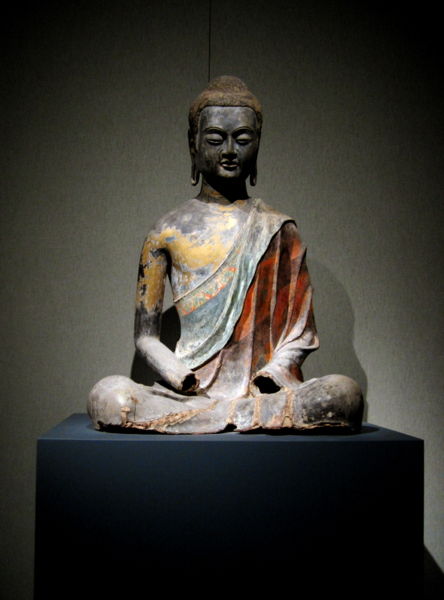Image:Mahayanabuddha.jpg
From Wikipedia, the free encyclopedia

Size of this preview: 444 × 600 pixel
Image in higher resolution (1493 × 2016 pixel, file size: 961 KB, MIME type: image/jpeg)
Summary
From Hebei, Tang Dynasty.
The MET
Seated Buddha, Tang dynasty, ca. 650
China
Dry lacquer with traces of gilt and polychrome pigments; H. 38 in. (96.5 cm); W. 27 in. (68.6 cm) Rogers Fund, 1919 (19.186)
Buddhist images executed in dry lacquer were highly valued by the Chinese because of their costly and time-consuming process of production. There are so few surviving examples that this seated Buddha is especially precious. To fashion the body of the image, the craftsman made a rough form of the sculpture in clay and then applied at least three layers of hemp cloth, each secured with a paste made of raw lacquer (the sap from the lac tree, Rhus verniciflua) and a fine powder of bone, horn, shell, ceramic, stone, or carbon. Each layer had to dry thoroughly before the next could be added. The clay core was then removed from the lacquered image. The head and hands were likely modeled separately, using the same technique as that used for the body, and then attached to the sculpture. The surface was finished with several coatings of pure lacquer and then painted. Portrayed as a youthful figure, the Buddha sits in the full lotus position, with his legs tightly interlocked, though the lower part of the sculpture is missing. The position of the damaged arms suggests that the hands performed the "contemplation" gesture.
The columnar form and lean gracefulness of the figure recall the style of Buddhist sculptures of the late Six Dynasties, but the attempt to render anatomical differentiation and, in particular, the emotional impact of the Buddha's expression are distinguishing features of early Tang style. The traces of brilliant red and blue, vividly combined to form a stylized floral pattern in the hem of the undergarment crossing the chest, and the remains of shimmering gilt on the surface are evidence of the sumptuous effect of this once colorful figure.
http://www.flickr.com/photo_zoom.gne?id=86745965&size=l
Licensing
|
|
This image is licensed under the Creative Commons Attribution ShareAlike License v. 2.5: http://creativecommons.org/licenses/by-sa/2.5/ |
File history
Legend: (cur) = this is the current file, (del) = delete this old version, (rev) = revert to this old version.
Click on date to download the file or see the image uploaded on that date.
- (del) (cur) 20:39, 21 November 2006 . . Naus ( Talk | contribs) . . 1493×2016 (984,479 bytes) (From Hebei, Tang Dynasty. The MET Seated Buddha, Tang dynasty, ca. 650 China Dry lacquer with traces of gilt and polychrome pigments; H. 38 in. (96.5 cm); W. 27 in. (68.6 cm) Rogers Fund, 1919 (19.186) Buddhist images executed in dry lacquer were hi)
-
Edit this file using an external application
See the setup instructions for more information.
File links
- Buddha
- Chinese Buddhism
- Buddhism
- Image:Mahayanabuddha.jpg
- User talk:Larry Rosenfeld/sandbox1
- Buddhism and psychology
- User:Selfworm/Userboxes
- User:Selfworm/TemplatesCreated
- User:Selfworm/Buddhism
- Meaghan
Metadata
This file contains additional information, probably added from the digital camera or scanner used to create or digitize it. If the file has been modified from its original state, some details may not fully reflect the modified image.
| Camera manufacturer | Canon |
|---|---|
| Camera model | Canon DIGITAL IXUS 400 |
| Orientation | Normal |
| Horizontal resolution | 72 dpi |
| Vertical resolution | 72 dpi |
| Software used | QuickTime 7.0.4 |
| File change date and time | 22:06, 14 January 2006 |
| Y and C positioning | 1 |
| Exposure time | 1/10 sec (0.1) |
| F-number | f/2.8 |
| Exif version | 2.2 |
| Date and time of data generation | 17:52, 30 December 2005 |
| Date and time of digitizing | 17:52, 30 December 2005 |
| Image compression mode | 3 |
| Shutter speed | 3.3125 |
| Aperture | 2.96875 |
| Maximum land aperture | 2.96875 |
| Metering mode | Pattern |
| Flash | 16 |
| Lens focal length | 7.40625 mm |
| Colour space | sRGB |
| Focal plane X resolution | 8114.28571429 |
| Focal plane Y resolution | 8114.28571429 |
| Focal plane resolution unit | inches |
| Sensing method | One-chip colour area sensor |
| Custom image processing | Normal process |
| Exposure mode | Manual exposure |
| White Balance | Manual white balance |
| Digital zoom ratio | 1 |
| Scene capture type | Standard |
Categories: Copy to Wikimedia Commons | Creative Commons Attribution-ShareAlike 2.5 images
